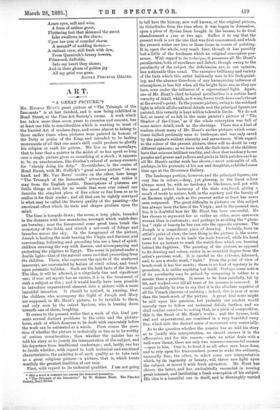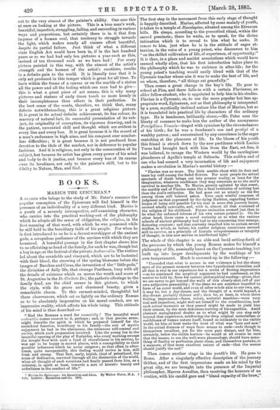ART.
"A GREAT PICTURE."t
Ma. HOLMAN HUNT'S great picture of "The Triumph of the Innocents" is at last finished, and is now being exhibited in iBond Street, at the Fine-Art Society's rooms. A work which has taken more than seven years to conceive and execute, has at least one title to consideration which is wanting to most of the hurried Art of modern days, and seems almost to belong to those earlier times when pictures were painted in honour of the Deity or praise of the King, and intended to be lasting monuments of all that one man's skill could produce to glorify his religion or exalt his patron. We live so fast nowadays, that to hear that a painter in the midst of us has spent so long over a single picture gives us something of a shock ; it appears to be an anachronism, like Gordon's refusal of money-rewards for "simply doing his duty." Nevertheless, in the centre of Bond Street, with Mr. Gullick's "great mirror picture" on one hand, and Mr. Van Beers' cocottes on the other, here hangs
The Triumph of the Innocents," attracting what notice it may from the English public. Descriptions of pietures axe futile things at best, for no words that were ever coined can describe the simplest piece of fine colour or fine form so as to realise it for their reader; and all that can be rightly conveyed is what may be called the literary quality of the painting—the emotional effect which its tints and shapes produce upon the mind.
The time is towards dawn ; the scene, a long plain, bounded in the distance with low mountains, amongst which watch-fires are burning; near the foreground some great trees break the monotony of the fields, and stretch a net-work of foliage and branches across the sky. In the foreground of the picture, Joseph is leading the mule bearing the Virgin and Saviour, and surrounding, following, and preceding him are a band of spirit. children strewing the way with flowers, and accompanying and protecting the pilgrims to Egypt. The scene is painted under a double light—that of the natural scene and that proceeding from the children. These, who represent the spirits of the martyred innocents, are surrounded by haloes of vivid colour, and tread upon prismatic bubbles. Such are the bald facts of the design. The idea, it will be allowed, is a singularly fine and significant one; if ever art mystic has an excuse, it is in the treatment of such a subject as this ; and it would hardly have been possible to introduce supernatural element into a picture with a more beautiful intention. It should be noticed, in passing, that the children who accompany the flight of Joseph and Mary are supposed, in Mr. Hunt's picture, to be invisible to them, and only seen by the infant Saviour, who is leaning down -towards one of them, laughing.
It seems to the present writer that a work of this kind presents several distinct problems to the critic and the picturelover, each of which deserves to be dealt with separately before the work can be estimated as a whole. First comes the quesetion of whether the picture is technically so fine as to be worthy of serious consideration ; then whether the painter has so told his story as to justify his interpretation of the subject, and his departure from traditional renderings ; and, lastly, one has to decide whether, with regard to both technical and emotional characteristics, the painting is of such quality as to take rank as a great religions picture—a picture, that is, which treats worthily the greatest tradition of our race.
First, with regard to its technical qualities. I am not going
to tell here the history, now well known, of the original picture, its vicissitudes from the time when it was begun in Jerusalem, upon a piece of Syrian linen bought in the bazaar, to its final abandonment a year or two ago. Suffice it to say that the present work is not the one that was first commenced, and which the present writer saw two or three times in course of painting. It is, upon the whole, very much finer, though it has possibly lost a little of the freshness which an original conception possesses. With regard to its technique, it possesses all Mr. Hunt's peculiarities, both of excellence and defect; though owing to the peculiarity of the subject the deficiencies are, in our opinion, less noticeable than usual. The excessive brilliancy and variety of the tints which this artist habitually uses in his flesh-painting, and the absence therefrom of any harmonising influence of atmosphere, is less felt when all the bright faces are, as they are here, seen under the influence of a supernatural light. Again, one of Mr. Hunt's chief technical peculiarities is a certain hard veracity of detail, which, as it were, forces truth down one's throat at the sword's-point. In the present picture, owing to the subdued light in which all the natural details and the principal figures are painted, this veracity is kept within tolerable limits. We do not feel, as many of us felt in the same painter's pieture of "The Shadow of the Cross," as if the whole conception was full of some minor detail, such as the shavings. There was a kind of realism about many of Mr. Hunt's earlier pictures which sometimes drifted perilously near to burlesque, and was only saved by the painter's evident sincerity and earnestness. With regard to the colour of the present picture, there will no doubt be very different opinions ; as we have said, the flesh-tints of the children have that extreme brilliant crudity, and show that tendency to see purples and greens and yellows and pinks in little patches such as all Mr. Hunt's earlier work has shown,—most noticeable of all, perhaps, in his portraits of his son and daughter, exhibited some time ago at the Grosvenor Gallery.
The landscape portion, however, and the principal figures, are very fine in colour,—deep, yet glowing, as the finest colour always must be, with no tendency to blackness, and yet with the most perfect harmony of the tints employed, giving a result of truth to nature, both in the mystery and the beauty of an Eastern night, such as the present writer at least has never seen surpassed. The great difficulty in pictures on this subject has always been the face of the Virgin ; and in the present case, too, it is doubtful how far Mr. Hunt has been successful. He has chosen to represent her as rather an older, more careworn woman than is customary ; and perhaps in avoiding the " plumbox " style of beauty he has run into the opposite extreme. The Joseph is a magnificent piece of drawing. Probably, from an artist's point of view, the best thing in the picture is the movement of his body as he leads the mule forward, while his head turns for an instant to mark the watch-fires which aro burning behind the fugitives. The painting of the picture, as opposed to its drawing and colour, varies in no essential. degree from the artist's previous work. It is careful in the extreme, laboured, and, to use a studio word, "tight." From the point of view of brush-work it has few merits ; there is no hint of mystery in its procedure, it is unlike anything but itself. Perhaps some notion of its peculiarity may be gained by comparing it rather to a mosaic than a painting. It seems to be done painfully, bit by bit, and worked-over till all trace of its process is removed. It would probably be true to say that it is the absolute negative of all the French theories of painting ; indeed, this is true of more than the brush-work of the picture. A great deal more might be said upon this question, but probably our readers would scarcely care to follow out technical details further, and we shall confine ourselves to noting that, as a piece of composition, this is the finest of Mr. Hunt's works ; and the figures, both real and supernatural, are combined in a very beautiful wavy line, which aids the desired sense of movement very materially.
As to the question whether the painter has so told his story as to justify this interpretation, we should answer it in the affirmative, and for this reason,—when an artist deals with a well-worn theme, there are only two courses—successful courses —open to him. One is, to treat it as all other men have done, and to rely upon his transcendent power to make the ordinary, unusually fine; the other, to select some new interpretation which, by its ingenuity or beauty, will, throw new light upon the subject, or invest it with fresh attraction. Mr. Hunt has chosen the latter, and has undoubtedly succeeded in rousing great interest, and instituting a fresh conception of his subject. His idea is a beautiful one in itself, and is thoroughly carried
■■•••■•00.1..1,•••■•■■•,
out to the very utmost of the painter's ability. One sees this at once on looking at the picture. This is a true man's work, beautiful, imperfect, struggling, failing, and succeeding in various ways and proportions, but certainly there is in it that firm impress of a human soul, that tendency to struggle towards the light, which makes nearly all sincere effort beautiful, despite its partial failure. Just think of what a different state English Art would have been in, if in the last hundred years or so we had had only ten pictures a year-such as this, instead of ten thousand such as we have had ! For every picture painted in this way, with the utmost of the artist's strength and the keenest of the artist's emotions, results in a definite gain to the world. It is literally true that it is only art produced in this temper which is great for all time. To have within the frame of a canvas or on the marble of a statue all the power and all the feeling which one man had to give— this is what a great piece of art means, this is why many pictures and statues of early times touch us more keenly in their incompleteness than others in their perfection. In the best sense of the words, therefore, we think that, many defects notwithstanding, this is a great religions picture. It is great in its actual definite achievement, its fine colour, its mastery of natural fact, its successful presentation of its subject, its originality of conception, its vigorous drawing, and in the patient, unwearied skill and thought which are evident in every line and every hue. It is great because it is the record of a man's endurance in high aims, and his conquest over numberless difficulties ; it is great because it is not produced from devotion to the idols of the market, nor in deference to popular fashions. And it is religious, not only in the consecration of its subject, but because its artist has given every power of his mind and body to do it justice, and because every hue of its canvas owes its loveliness, not only to the painter's skill, but to his fidelity to Nature, Man, and God.



































 Previous page
Previous page